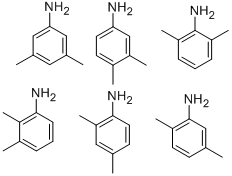Potential Exposure
Xylidines are used in dyestuff
manufacture; as intermediates in the manufacture of pesticides,
antioxidants, pharmaceuticals, and other organic com
pounds.
First aid
If this chemical gets into the eyes, remove any
contact lenses at once and irrigate immediately for at least
15 minutes, occasionally lifting upper and lower lids. Seek
medical attention immediately. If this chemical contacts the
skin, remove contaminated clothing and wash immediately
with soap and water. Seek medical attention immediately.
If this chemical has been inhaled, remove from exposure,
begin rescue breathing (using universal precautions, including
resuscitation mask) if breathing has stopped and CPR if
heart action has stopped. Transfer promptly to a medical
facility. When this chemical has been swallowed, get
medical attention. Give large quantities of water and induce
vomiting. Do not make an unconscious person vomit.
Shipping
UN1711/Xylidines, solid or liquid, Hazard
Class: 6.1; Labels: 6.1-Poisonous materials.
Incompatibilities
Vapor may form explosive mixture with
air. Contact with hypo chlorite salts and bleaches form
explosive chloroamines. Incompatible with oxidizers (chlorates,
nitrates, peroxides, permanganates, perchlorates,
chlorine, bromine, fluorine, etc.); contact may cause fires
or explosions. Keep away from alkaline materials, strong
bases, strong acids, oxoacids, and epoxides. A chemical
base: Will neutralize acids to form salts plus water with an
exothermic reaction. May be incompatible with isocyanates,
halogenated organics, peroxides, phenols (acidic),
epoxides, anhydrides, and acid halides. Flammable gaseous
hydrogen is generated by amines in combination with
strong reducing agents such as hydrides, nitrides, alkali
metals, and sulfides.
Description
There are six xylidine isomers. Xylidine,mixed isomers (principally made up of 2,4-, 2,5-, and 2,6-isomers), is a pale yellow to brown liquid with a weak,aromatic amine odor. The odor threshold is 0.056 ppm.Molecular weight=121.20; Specific gravity (H2O:1) =0.98 at 25℃; Boiling point (mixed isomers) =213-226℃;Freezing/Melting point=236℃; Vapor pressure =<1 mmHg at 25℃; Flash point (2,6-isomer)= 91℃;(mixed isomers) 96.7℃. Explosive limits (2,6-isomer):LEL =1.0%; UEL—unknown. Hazard Identification (basedon NFPA-704 M Rating System): Health 3, Flammability 1,Reactivity 0. Insoluble in water.
Chemical Properties
Liquid. Slightly soluble inwater;
soluble in alcohol and ether. Combustible.
Chemical Properties
There are six xylidine isomers. Xylidine,
mixed isomers (principally made up of 2,4-, 2,5-, and
2,6-isomers) is a pale yellow to brown liquid with a weak,
aromatic amine odor.
Waste Disposal
Incineration; oxides of
nitrogen are removed from the effluent gas by scrubber,
catalytic, or thermal device.
Uses
Chemical intermediate in the manufacture
of pesticides, dyes, antioxidants, pharmaceuticals,
synthetic resins, and fragrances.
Uses
Chiefly in the manufacture of dyes.
Hazard
Toxic by ingestion, inhalation, and skin
absorption. Liver damage. Methemoglobinemia.
Possible carcinogen.
Health Hazard
Xylidine causes liver damage in
experimental animals and is a mild methemoglobin
former; it caused tumors of the nasal
cavity in rats.
There are six isomeric forms of xylidenes
with the commercial product consisting primarily
of the 2,4- and 2,6-isomers.
Carcinogenicity
The IARC has determined that there is
sufficient evidence for the carcinogenicity of
2,6-xylidine in experimental animals and inadequate
evidence in humans.5 Overall, 2,6-
xylidine is considered possibly carcinogenic to
humans.
In genotoxic assays, 2,6-xylidine induced
sister chromatid exchanges and chromosomal
aberrations in cultured mammalian cells but
did not induce micronuclei in the bone marrow
of mice treated in vivo; conflicting results have
been reported in the Salmonella typhimurium
assay.
storage
Color Code—Blue: Health Hazard/Poison: Storein a secure poison location. Prior to working with thischemical you should be trained on its proper handling andstorage. Before entering confined space where this chemicalmay be present, check to make sure that an explosiveconcentration does not exist. Xylidine must be stored toavoid contact with strong oxidizers (such as bromine,chlorine, or fluorine) since violent reactions occur. Contactwith hypochlorite bleaches may form explosive chloroamines. Store in tightly closed containers in a cool, dry,well-ventilated area away from heat sources. Sources ofignition, such as smoking and open flames, are prohibitedwhere this chemical is used, handled, or stored in a mannerthat could create a potential fire or explosion hazard. Metalcontainers involving the transfer of 5 gallons or more ofthis chemical should be grounded and bonded. Drums mustbe equipped with self-closing valves, pressure vacuumbungs, and flame arresters. Use only nonsparking tools andequipment, especially when opening and closing containersof this chemical. A regulated, marked area should beestablished where this chemical is handled, used, or storedin compliance with OSHA Standard 1910.1045.
